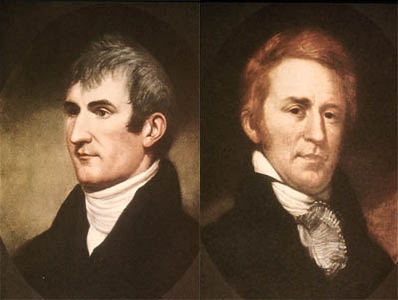Lewis and Clark: Dynamic Duo
Lewis and Clark were two explorers who played a big role in American history. In the early 1800s, President Thomas Jefferson sent them on an exciting adventure to explore the western part of the United States, which was largely unknown at the time. Meriwether Lewis and William Clark, along with a group of brave adventurers known as the Corps of Discovery, set out on a journey that took them through forests, across rivers, and over mountains. They wanted to learn more about the land, the plants, and the animals in the West. The explorers faced many challenges, including harsh weather, difficult terrain, and encounters with Native American tribes. However, they also made friends along the way, like Sacagawea, a Native American woman who helped them by acting as a guide and translator. After many months of exploration, Lewis and Clark successfully reached the Pacific Ocean. They documented their discoveries and drew maps to help others understand the vast and beautiful landscape they had explored. Their expedition, known as the Lewis and Clark Expedition, was a key part of America's westward expansion, helping to open up new opportunities for settlers and traders. Lewis and Clark's journey is remembered as an important chapter in American history, showcasing the spirit of exploration and discovery that has shaped the nation.

Fun Facts:
Dynamic Duo: Meriwether Lewis and William Clark were chosen by President Thomas Jefferson to lead the Corps of Discovery, an expedition to explore the vast unknown lands acquired through the Louisiana Purchase in 1803.
Sacagawea's Guidance: The expedition was joined by Sacagawea, a Shoshone woman, who played a crucial role as an interpreter and guide. She even carried her baby on this epic journey!
New Creatures: Lewis and Clark encountered many new plants and animals. They even sent some back to President Jefferson, like the prairie dog and a magpie.
Rocky Mountain High: The Corps crossed the challenging Rocky Mountains and faced extreme weather, from scorching heat to freezing cold.
Timelines:
1803 President Jefferson sends Lewis and Clark to explore the Louisiana Purchase.
1804-1806 The Corps of Discovery sets out from St. Louis, travels up the Missouri River, crosses the Rocky Mountains, and reaches the Pacific Ocean.
1806 The expedition returns to St. Louis after two years and four months.
Reference Books for Elementary Students:
"Who Were Lewis and Clark?" by James Buckley Jr. This book is part of the "Who Was?" series, providing an engaging and accessible introduction for young readers.
"Lewis and Clark for Kids: Their Journey of Discovery with 21 Activities" by Janis Herbert A hands-on guide that combines history with activities, making the learning experience interactive and fun.
"The Lewis and Clark Expedition (Graphic History)" by Jessica Gunderson A graphic novel format that appeals to visual learners, providing an exciting way to learn about this historic journey.
"The Lewis and Clark Expedition" by Peter Roop and Connie Roop A well-illustrated book that simplifies the story for young readers while maintaining historical accuracy.
These books offer a mix of engaging storytelling and educational content suitable for elementary students, making the Lewis and Clark expedition an exciting and accessible topic for young minds.